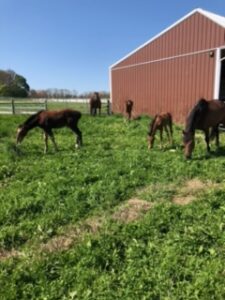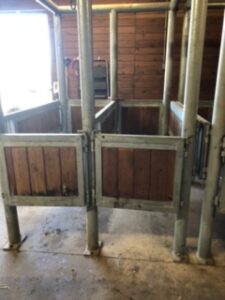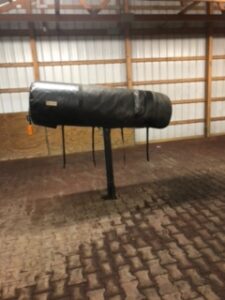For anyone interested in horse breeding, Delaware Valley University offers a one-of-a-kind, comprehensive, hands-on learning opportunity at their campus in Doylestown, PA. From conception to sale, students participate in the process of selecting and breeding a Standardbred stallion to a mare, caring for the broodmare through the eleven month gestation period, foaling, weaning, and handling the foal until its sale at the annual, November Standardbred Yearling Horse Sale in Harrisburg, PA.
 Long before a foal arrives, planning begins. Months before breeding season, Jenna Reigle, stable manager of the Equine Breeding Center, researches the pedigrees, conformation, and racing statistics of potential stallions for breeding to the school’s broodmares. With help and input from students in the stallion and mare management classes, they study a stallion’s racing career, speed, and soundness to find the most compatible match for their mares. Once a stallion is selected, a contract is signed and arrangements are made for obtaining semen. Standardbred mares are bred by artificial insemination – AI – which eliminates the need for transporting the mare and eliminates the chance of injury to the mare or stallion. Also, since semen can be frozen and shipped from anywhere in the country, AI increases a breeder’s choice. DelVal currently breeds about 12 mares with 7 foaling this year to sell as yearlings in 2023. The mares are donated from various owners including several from Hanover Shoe Farms. Hanover allows DelVal to use their mares for the program and then return them to Hanover for retirement.
Long before a foal arrives, planning begins. Months before breeding season, Jenna Reigle, stable manager of the Equine Breeding Center, researches the pedigrees, conformation, and racing statistics of potential stallions for breeding to the school’s broodmares. With help and input from students in the stallion and mare management classes, they study a stallion’s racing career, speed, and soundness to find the most compatible match for their mares. Once a stallion is selected, a contract is signed and arrangements are made for obtaining semen. Standardbred mares are bred by artificial insemination – AI – which eliminates the need for transporting the mare and eliminates the chance of injury to the mare or stallion. Also, since semen can be frozen and shipped from anywhere in the country, AI increases a breeder’s choice. DelVal currently breeds about 12 mares with 7 foaling this year to sell as yearlings in 2023. The mares are donated from various owners including several from Hanover Shoe Farms. Hanover allows DelVal to use their mares for the program and then return them to Hanover for retirement.
DelVal stands two Standardbred stallions, Flashbacks and Swift As A Shadow, and students learn about semen collection and evaluation. At DelVal, a phantom mount and a teasing stall is located in the breeding shed next to the lab. Phantom mounts are mare substitutes that mimic the contours and angles of a live mare. After a stallion is stimulated and aroused by a mare, the stallion mounts the phantom, and the semen is collected into an artificial vagina. The semen is then taken into the lab where the students evaluate it for sperm count and motility. Commercial breeding farms follow the same procedure, and after evaluation, the sperm is either used immediately or cooled or frozen for later use.
The gestation period for a horse is 11 months, and all race horses celebrate their birthdays on January 1, therefore breeding and foaling season starts in February. Prior to breeding, mares are evaluated, monitored, and ultrasounded by a local veterinarian. Semen insemination should be done close to the time of a mare’s ovulation, and students assist the vet when checking mares to learn about timing and technique. According to Jenna, “the veterinarian does the ultrasounds, but I do the insemination with the help of the students. The mare is secured in breeding stocks located in the main barn, and a plastic pipette is inserted through the cervix, and the semen is injected into the uterus. After 14 days, the vet does a pregnancy check using the ultrasound. If the mares are pregnant, we turn them out in our fields with run-in sheds and ultrasound them throughout their pregnancies. They usually stay out until close to their due dates, and then we bring them into our foaling stalls where we can monitor the mares 24 hours a day on our T.V. screens. Each student in the mare and foal management class is assigned a mare that he or she is responsible for. The students watch the monitors and call me when a mare goes into labor, and we hopefully foal the mare without problems.”
starts in February. Prior to breeding, mares are evaluated, monitored, and ultrasounded by a local veterinarian. Semen insemination should be done close to the time of a mare’s ovulation, and students assist the vet when checking mares to learn about timing and technique. According to Jenna, “the veterinarian does the ultrasounds, but I do the insemination with the help of the students. The mare is secured in breeding stocks located in the main barn, and a plastic pipette is inserted through the cervix, and the semen is injected into the uterus. After 14 days, the vet does a pregnancy check using the ultrasound. If the mares are pregnant, we turn them out in our fields with run-in sheds and ultrasound them throughout their pregnancies. They usually stay out until close to their due dates, and then we bring them into our foaling stalls where we can monitor the mares 24 hours a day on our T.V. screens. Each student in the mare and foal management class is assigned a mare that he or she is responsible for. The students watch the monitors and call me when a mare goes into labor, and we hopefully foal the mare without problems.”
 After foaling, students watch the newborns to make sure they get to their feet and nurse. The mare’s colostrum is vital to the health of a foal, and it is the first fluid the mare produces which is loaded with antibodies to protect the foal from infection. Students make sure the baby nurses within 6 -12 hours after birth, and they monitor the mare and foal for any sign of distress. Mares and newborn foals stay inside for a few days after birth so the students can keep a close eye on them and begin handling the babies.
After foaling, students watch the newborns to make sure they get to their feet and nurse. The mare’s colostrum is vital to the health of a foal, and it is the first fluid the mare produces which is loaded with antibodies to protect the foal from infection. Students make sure the baby nurses within 6 -12 hours after birth, and they monitor the mare and foal for any sign of distress. Mares and newborn foals stay inside for a few days after birth so the students can keep a close eye on them and begin handling the babies.
Several days after birth, students turn the mares and foals out for the first time. Foals are halter broke and taught to lead and turned out with other mares and foals where they run and play for several months until weaning time.
The next article deals with weaning the foals and preparing them for the yearling sale in November 2023.











